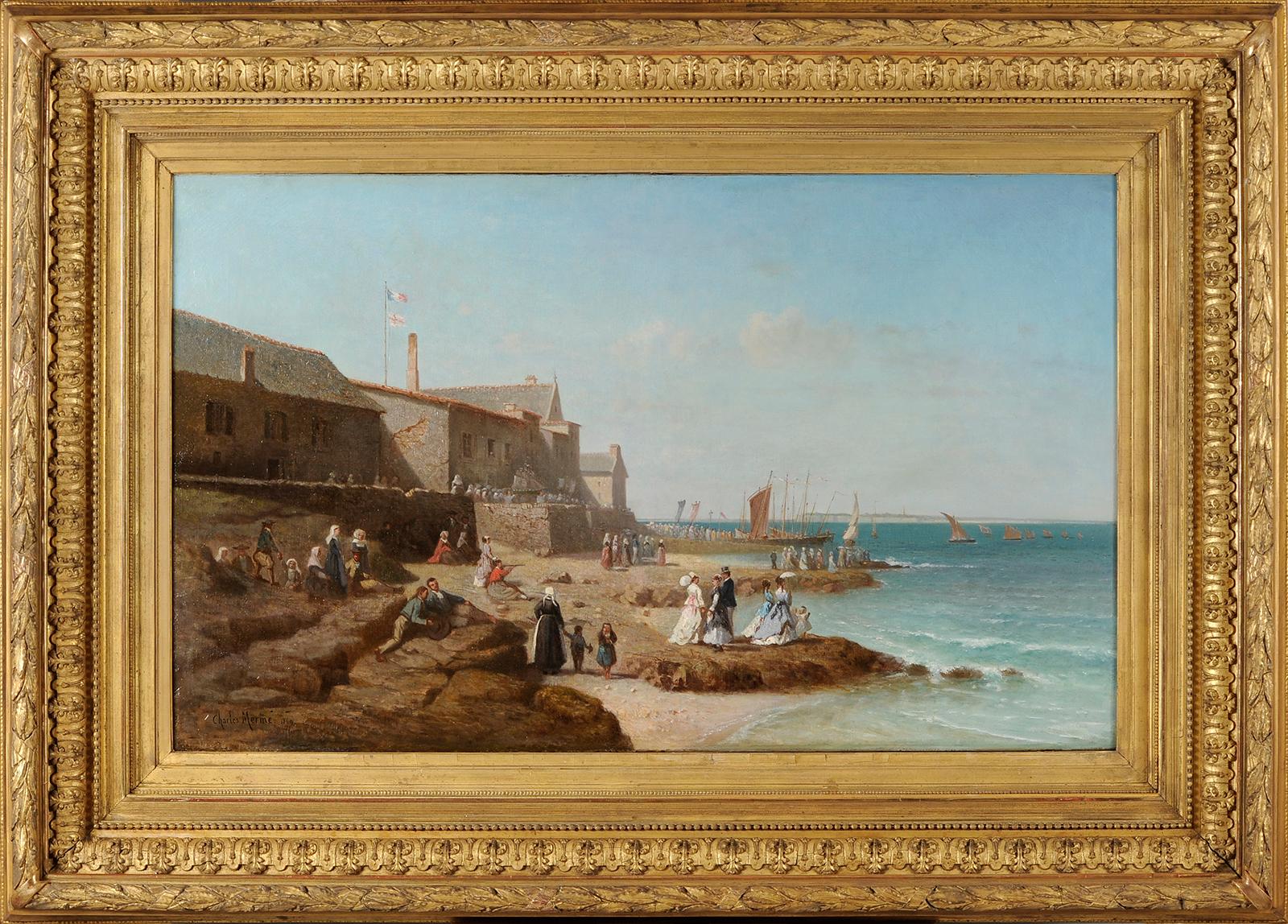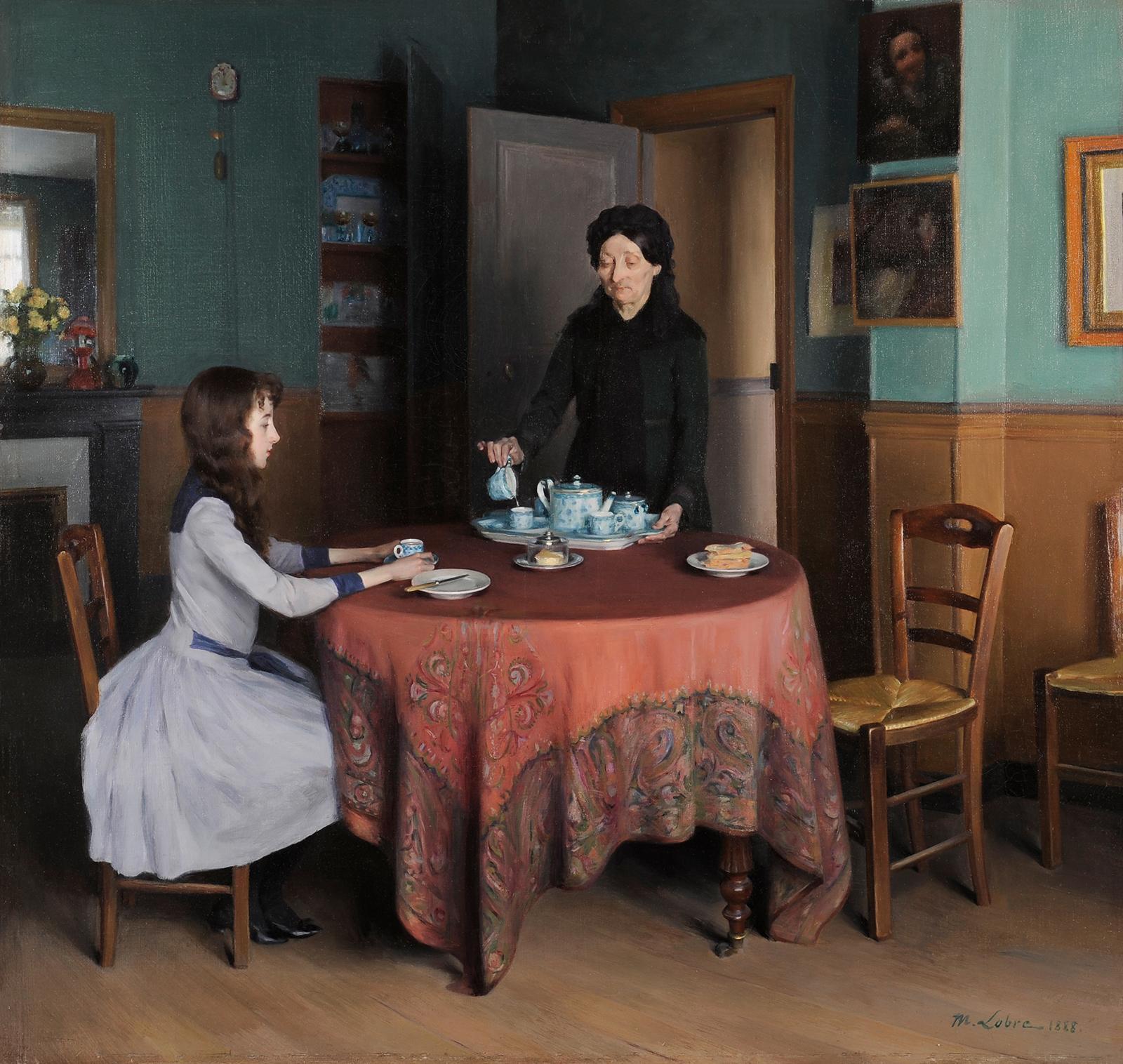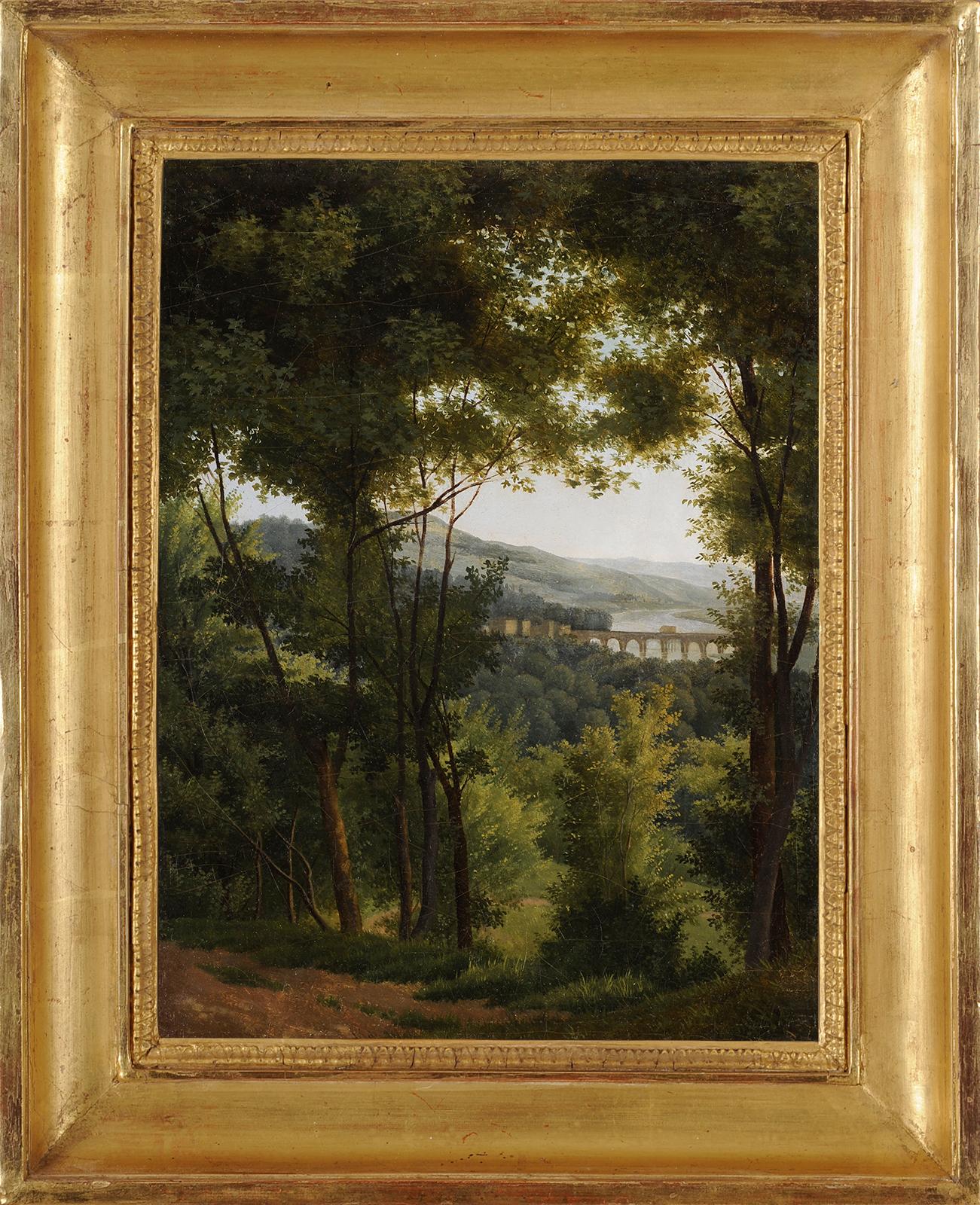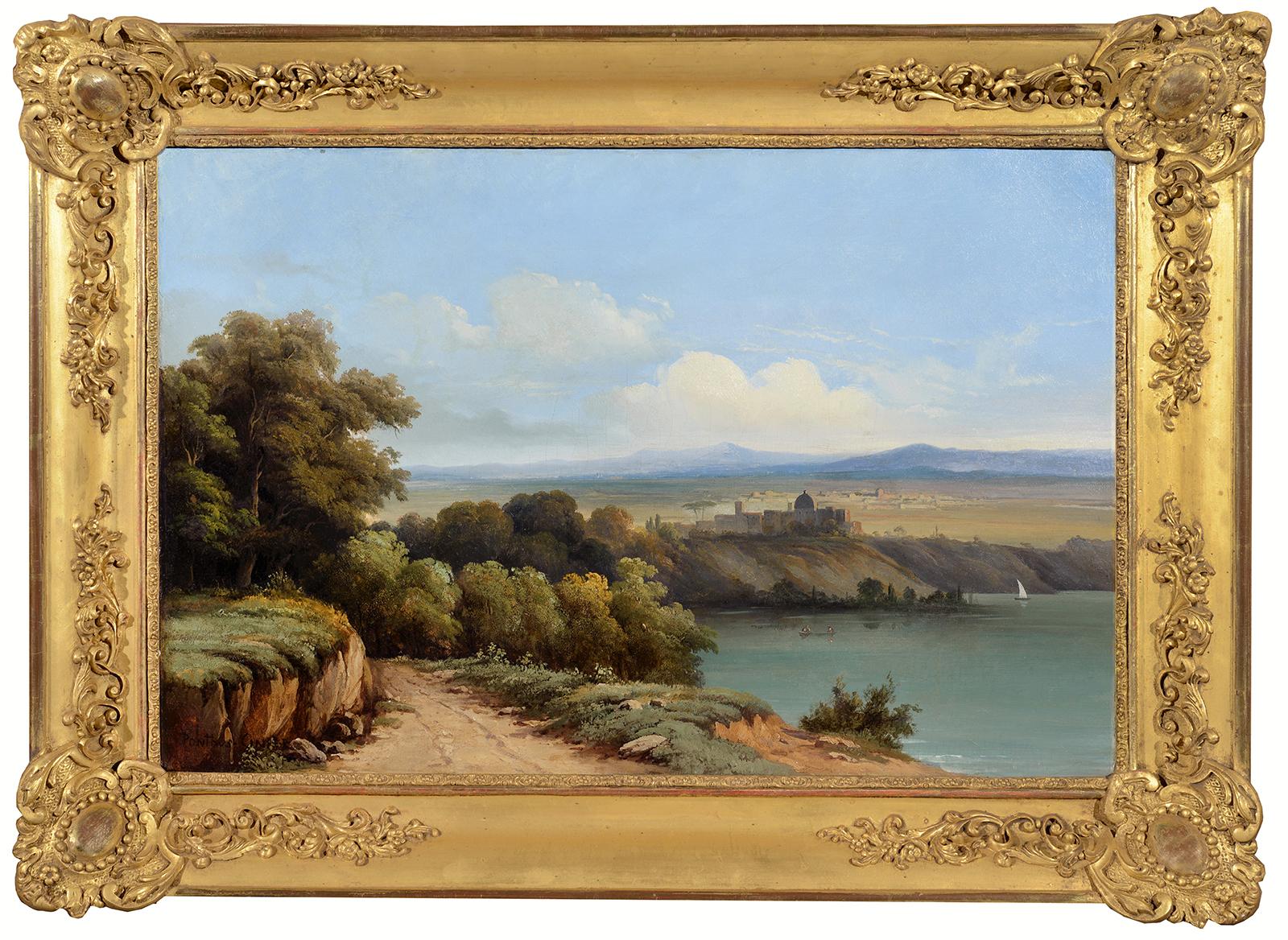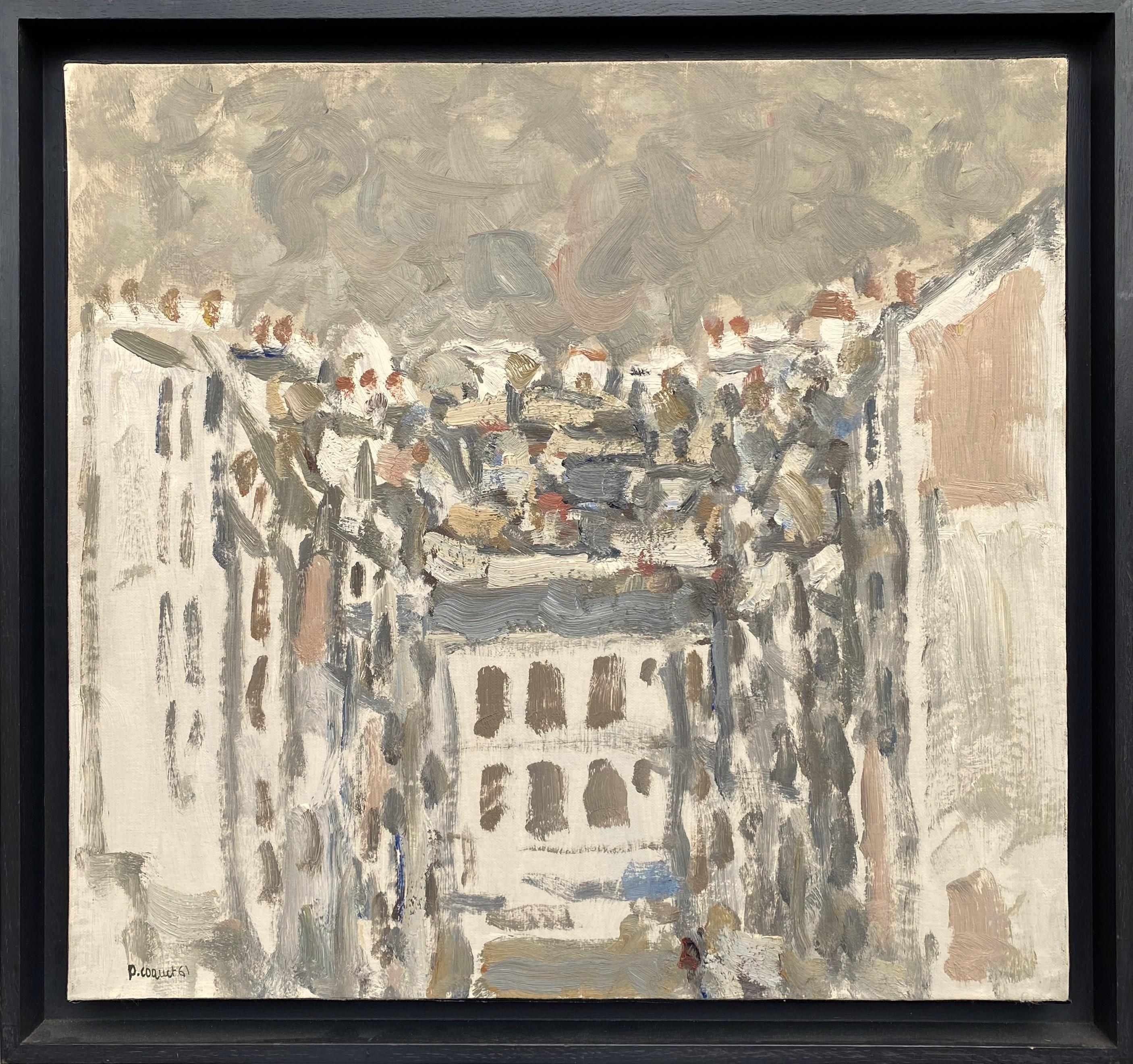Items Similar to A Mythological Scene, Early 1700s, Oil on Canvas
Want more images or videos?
Request additional images or videos from the seller
1 of 7
A Mythological Scene, Early 1700s, Oil on CanvasEarly 1700s
Early 1700s
About the Item
This exquisite painting, attributed to the circle of Charles Antoine Coypel, presents a mythological scene. Though the artist remains unknown, the work clearly echoes the style of the early 18th century, with soft, dreamlike qualities and a masterful use of light and shadow. The tableau likely portrays the legendary figures of Thetis and Hephaestus (Faistos), with the young Achilles – a narrative rich with heroism and divine intervention.
The central figures are rendered with a tenderness and dynamism that speak to the era's fascination with Greco-Roman mythos. Thetis, with her maternal grace, appears to interact with Hephaestus, whose artisanal prowess was renowned even among the gods. Young Achilles, later to become the hero of the Trojan War, listens intently, hinting at the weighty fate that awaits him.
A delicate, rosy shimmer pervades the canvas, bringing an ethereal glow that enlivens the mythic scene. This effect, coupled with the painting's warm palette and the subtle play of light, creates a sense of immediacy and importance, as if the viewer is privy to a pivotal moment in the ancient stories.
This piece is a true treasure for those who appreciate the blend of history, mythology, and art.
The beautiful golden frame is included in the purchase.
Information:
oil on canvas
unframed 9,45 x 13,00 inches (24 x 33 cm)
- Creation Year:Early 1700s
- Dimensions:Height: 9.45 in (24 cm)Width: 13 in (33 cm)
- Medium:
- Movement & Style:
- Circle Of:Charles Antoine Coypel (1694 - 1752, French)
- Period:
- Condition:frame with minor flaws, overall good condition.
- Gallery Location:Stockholm, SE
- Reference Number:1stDibs: LU1445213703322
About the Seller
5.0
Platinum Seller
These expertly vetted sellers are 1stDibs' most experienced sellers and are rated highest by our customers.
Established in 2020
1stDibs seller since 2020
118 sales on 1stDibs
Typical response time: <1 hour
Associations
International Confederation of Art and Antique Dealers' Associations
- ShippingRetrieving quote...Ships From: Stockholm, Sweden
- Return PolicyA return for this item may be initiated within 2 days of delivery.
More From This SellerView All
- A Soldier Blowing the Trumpet by French Artist Charles Bouchez, Oil on CanvasLocated in Stockholm, SECharles Bouchez (1811-1882) French A Soldier Blowing the Trumpet oil on canvas signed and dated ch. Bouchez 1842 canvas dimensions 6.29 x 4.13 inches (16 x 10.5 cm) frame 10.23 x 7...Category
1840s French School Figurative Paintings
MaterialsOil, Canvas
- Shipping in Stormy Waters, Attributed to Italian Artist Francesco GuardiBy Francesco GuardiLocated in Stockholm, SEThe splendour of the tragic sea Francesco Guardi and maritime painting in Venetian art No Venetian painter was a stranger to the sea. After all, Venice was not only one of the most prominent ports of the Mediterranean, but indeed a city literally submerged in the ocean from time to time. Curiously however, the famous Venetian school of painting showed little interest in maritime motifs, favouring scenes from the iconic architecture of the city rather than seascapes. That is why this painting is a particularly interesting window into not only the painter Francesco Guardi himself – but to the significance of the element of water in art history, in absence as well as in the centre of attention. Whether it be calm, sunny days with stunning views of the palaces alongside the canals of Venice or – more rarely – stormy shipwrecking tragedies at sea, water as a unifying element is integral to the works of painter Francesco Guardi (1712–1793). During his lifetime, Venetian art saw many of its greatest triumphs with names like Tiepolo or Canaletto gaining international recognition and firmly establishing Venice as one of the most vibrant artistic communities of Europe. While the city itself already in the 18th century was something of an early tourist spot where aristocrats and high society visited on their grand tour or travels, the artists too contributed to the fame and their work spread the image of Venice as the city of romance and leisure to an international audience, many of whom could never visit in person. Still today, the iconic image of Venice with its whimsical array of palaces, churches and other historic buildings is much influenced by these artists, many of whom have stood the test of time like very well and remain some of the most beloved in all of art history. It was not primarily subtility, intellectual meanings or moral ideals that the Venetian art tried to capture; instead it was the sheer vibrancy of life and the fast-paced city with crumbling palaces and festive people that made this atmosphere so special. Of course, Venice could count painters in most genres among its residents, from portraiture to religious motifs, history painting and much else. Still, it is the Vedutas and views of the city that seems to have etched itself into our memory more than anything else, not least in the tradition of Canaletto who was perhaps the undisputed master of all Venetian painters. Born into his profession, Francesco lived and breathed painting all his life. His father, the painter Domenico Guardi (1678–1716) died when Francesco was just a small child, yet both he and his brothers Niccolò and Gian Antonio continued in their fathers’ footsteps. The Guardi family belonged to the nobility and originated from the mountainous area of Trentino, not far from the Alps. The brothers worked together on more challenging commissions and supported each other in the manner typical of family workshops or networks of artists. Their sister Maria Cecilia married no other than the artist Giovanni Battista Tiepolo himself, linking the family to the most renowned Venetian name of the time. During almost a decade, Guardi worked in the studio of Michele Giovanni Marieschi, sometimes simply known as Michiel, a painted similar in both style and motif. Canaletto is, however, the artist Guardi is most often compared to since they shared a mutual fascination for depicting the architecture and cityscape of Venice. During the course of his career, Guardi tried his hand in many different genres. He was as swift in painting landscapes, Vedutas of Venice, sacred motifs, interiors and architectural compositions as he was in a number of other motifs. His style is typical of the Venetian school but also distinct and personal once we look a little closer. There is an absolute certainty in the composition, the choice of which sometimes feels like that of a carefully calculated photograph – yet it is also very painterly, in the best sense of the word: fluid, bold, sensitive and full of character. The brushwork is rapid, intense, seemingly careless and extraordinarily minute at the same time; fresh and planned in a very enjoyable mixture. His interiors often capture the breath-taking spacious glamour of the palaces and all their exquisite decor. He usually constructed the motif through remarkably simple, almost spontaneous yet intuitively precise strokes and shapes. The result was a festive, high-spirited atmospheric quality, far away from the sterile and exact likeness that other painters fell victim to when trying to copy Canaletto. The painting here has nothing of the city of Venice in it. On the contrary, we seem to be transported far away into the solitary ocean, with no architecture, nothing to hold on to – only the roaring sea and the dangerous cliffs upon which the ships are just moments away from being crushed upon. It is a maritime composition evoking both Flemish and Italian precursors, in the proud tradition of maritime painting that for centuries formed a crucial part of our visual culture. This genre of painting is today curiously overlooked, compared to how esteemed and meaningful it was when our relationship to the sea was far more natural than it is today. When both people and goods travelled by water, and many nations and cities – Venice among them – depended entirely on sea fare, the existential connection to the ocean was much more natural and integrated into the imagination. The schools and traditions of maritime art are as manifold as there are countries connected to the sea, and all reflect the need to process the dangers and wonders of the ocean. It could symbolize opportunity, the exciting prospects of a new countries and adventures, prospering trade, beautiful scenery as well as war and tragedy, loss of life, danger and doom. To say that water is ambivalent in nature is an understatement, and these many layers were something that artists explored in the most wondrous ways. Perhaps it takes a bit more time for the modern eye to identify the different nuances and qualities of historic maritime paintings, they may on first impression seem hard to differentiate from each other. But when allowing these motifs to unfold and tell stories of the sea in both fiction and reality – or somewhere in between – we are awarded with an understanding of how the oceans truly built our world. In Guardi’s interpretation, we see an almost theatrically arranged shipwrecking scene. No less than five ships are depicted right in the moment of utter disaster. Caught in a violent storm, the waves have driven them to a shore of sharp cliffs and if not swallowed by the waves, crushing against the cliffs seems to be the only outcome. The large wooden ships are impressively decorated with elaborate sculpture, and in fact relics already during Guardi’s lifetime. They are in fact typical of Dutch and Flemish 17th century ships, giving us a clue to where he got the inspiration from. Guardi must have seen examples of Flemish maritime art, that made him curious about these particular motifs. One is reminded of Flemish painters like Willem van de Velde and Ludolf Backhuysen, and this very painting has indeed been mistakenly attributed to Matthieu van Plattenberg...Category
18th Century Old Masters Landscape Paintings
MaterialsCanvas, Oil
- View of a Dutch Town by Jan van Couver (Hermanus Koekkoek Jr.) ImpressionismBy Jan Van CouverLocated in Stockholm, SEHermanus Koekkoek the Younger was part of the famous Koekkoek artist family: grandson of Johannes Hermanus Koekkoek, nephew of the landscape painter, Barend Cornelis Koekkoek...Category
Late 19th Century Impressionist Landscape Paintings
MaterialsCanvas, Oil
- Impressionistic Summer Landscape with Road Painted 1889Located in Stockholm, SECarl Johansson's "Summer Landscape with Road" is an exquisite landscape that encapsulates the serene beauty of the Swedish countryside. Painted in 1889, the same year Johansson showcased his work at the Exposition Universelle in Paris, one can't help but wonder if this very painting was among those displayed at the fair. "Summer Landscape with Road" offers a glimpse into the idyllic Swedish countryside through its masterful depiction. The scene is bathed in the distinctive light of the sun positioned at 30 degrees north-northwest, a unique aspect of Johansson's artworks. The viewer's eye is drawn along a winding dirt road that meanders through a tranquil pastoral landscape. Birch trees, with their white bark and tender green leaves, stand tall and sway gently, marking the passage toward a distant homestead nestled beside a calm lake. The rustic wooden fences and the clear sky, dotted with soft, billowing clouds, evoke a sense of peaceful solitude. Johansson's meticulous attention to detail and colour is evident in every brushstroke, from the lush greenery to the soft, earthy path leading to the horizon. The artist's signature use of light not only highlights the natural beauty of the North but also enhances the sense of depth and realism in the painting. Johansson's early works, such as this one, are exceedingly rare, making "Summer Landscape with Road" not only a visual delight but also a collector's gem. The painting's magnificent gold frame enhances the bright, vivid colours of the small-format artwork, creating an impactful presence. Carl Johansson's blue impressionistic depictions of Northern Sweden earned him the nickname "Ultramarine Johansson", and his paintings are celebrated in prestigious collections, including the Nationalmuseum in Stockholm, Kalmar Art Museum, and the municipality of Hudiksvall. oil on canvas signed and dated Carl Johansson . 89 . unframed 27 x 39 cm framed 41,5 x 53 cm Provenance: The previous owner bought it in 1988 at Åmells Stockholm...Category
1880s Impressionist Landscape Paintings
MaterialsCanvas, Oil
- Summer Day on the West Coast of Sweden by Swedish Impressionist Alfred WahlbergLocated in Stockholm, SEAlfred Wahlberg was a distinguished Swedish landscape painter whose career spanned Germany, France, and Sweden. During his early years, he resided in D...Category
Late 19th Century Impressionist Landscape Paintings
MaterialsCanvas, Oil
- Silent Night (Stilla natt), 1921, Large Moonlight Oil PaintingLocated in Stockholm, SE"Silent Night, 1921" by Gottfrid Kallstenius is a wonderful painting that captures the beauty of the Swedish archipelago in moonlight. In our opinion, we think that this painting is ...Category
1920s Landscape Paintings
MaterialsCanvas, Oil
You May Also Like
- Charles Merme (1818-1869) The blessing of Coureau de Groix in Larmor BrittanyLocated in BELEYMAS, FRCharles MERMÉ (Cherbourg 1818 - Lorient 1869) The blessing of Coureau de Groix at Larmor Oil on canvas H. 60 cm; W. 100 cm Signed and dated lower left, 1...Category
1860s French School Figurative Paintings
MaterialsCanvas, Oil
- Maurice Lobre (1862 -1951) The snackBy Maurice LobreLocated in BELEYMAS, FRMaurice LOBRE (Bordeaux 1862 - Paris 1951) Le goûter Huile sur toile H. 87 cm ; L. 91,5 cm Format peint d’origine, H. 101 cm ; L. 96 cm, disposé sur un châssis plus petit par l’artiste lui-même. Signée et datée 1888 en bas à droite Provenance : Collection privée, Lyon Exposition : 1889, Salon des Artistes Français, n°1719 « Intérieur », (ou 1720 nommé également « Intérieur ») Œuvres en rapport : Le Cabinet de toilette de Jacques-Emile Blanche, (titre erroné) H. 80 cm ; L. 85 cm, HST, Museo Thyssen-Bornemisza, Madrid, pendant de notre toile. Maurice Lobre a-t-il connu Marcel Proust ? On ne peut encore l'affirmer, bien qu'il ait eu de nombreux amis en commun avec l'écrivain. Mais sa peinture intimiste pourrait illustrer certaines pages de Du côté de chez Swann. Trois citations dues à des proches de Proust, l'une de l'écrivain Léon Daudet, la seconde du peintre Jacques-Emile Blanche, la dernière du poète mondain Robert de Montesquiou, donnent un aperçu de ce que fut la renommée de Maurice Lobre en son temps : "Il en va autrement de Lobre, le Vermeer français, le peintre exquis des intérieurs et des palais de Versailles, des reflets sur les meubles rares, de la lumière prisonnière des miroirs, des laques et des cuivres polis. Lobre est joyeux comme un coup de vent, qui fait envoler les préjugés et les poncifs, éloquent, passionné, ivre de la couleur et des formes, charmant et conquérant de toutes les matières. Il se promène ici-bas ainsi que dans un musée en plein-air, s'amuse de tout, rejette et maudit le laid et le vil, accueille et bénit le beau et le bien…" Léon Daudet L'Entre-deux-guerres. Souvenirs des milieux littéraires, politiques, artistiques et médicaux de 1880 à 1905. "Voici le patient, appliqué, sage M. Lobre. Il est difficile de mettre plus d'honnêteté à peindre des intérieurs sans figures. Je préfère ses petits salons de Versailles à ses cathédrales… Nous lui devons des petits bijoux d'émotion et de large fini." Jacques-Emile Blanche "Il a recueilli sur des toiles le visage du vieux Versailles (…). Il a peuplé de visions impalpables des chambres " où il s'est passé quelque chose ", et il en a saturé l'atmosphère de particules historiques. Donner une telle impression avec certitude, avec vérité, c'est plus difficile que de faire évoluer des personnages costumés, dans ce qu'on appelle bêtement "une reconstitution historique"." Comte Robert de Montesquiou Maurice Lobre commence sa carrière au Salon de 1882 où il expose deux portraits, dont celui de son camarade de l'atelier Carolus-Duran, le peintre espagnol Ramon Casas...Category
1880s French School Figurative Paintings
MaterialsCanvas, Oil
- View taken in the Park of Saint-Cloud near ParisLocated in BELEYMAS, FRAlexandre-Hyacinthe DUNOUY (Paris, 1757 – Jouy en Josas, 1841) View taken in the park of Saint-Cloud Oil on paper mounted on canvas H. 31.5 cm; L. 24 cm Around 1820 Provenance: -Per...Category
1810s French School Figurative Paintings
MaterialsCanvas, Oil
- Lake Albano, Castel Gandolfo ItalyBy Antoine Ponthus-CinierLocated in BELEYMAS, FRAntoine-Claude PONTHUS-CINIER (Lyon, 1812 - Lyon, 1885) Lake Albano, Castel Gandolfo and the Roman countryside Oil on canvas mounted on cardboard H. 38 cm; L. 55 cm Signed lower left Ponthus-Cinier belongs to what could be defined as the third (and so to speak last) generation of neo-classical or historical landscape painters, born in the years 1810/1820, like Félix Lanoüe, Achille Bénouville...Category
1840s French School Figurative Paintings
MaterialsCanvas, Oil
- François-Edme Ricois (1795-1881) View of Châteaudun castle and city in FranceLocated in BELEYMAS, FRFrançois-Edme RICOIS (Courtalain, 1795 - Mareil-Marly, 1881) View of Châteaudun Oil on canvas H. 65 cm; W. 98 cm Signed and dated lower center 1860 François-Edme Ricois although bor...Category
1840s French School Figurative Paintings
MaterialsCanvas, Oil
- View of Paris, oil painting by Pierre CoquetLocated in Montfort l’Amaury, FRReference number F367 The painting is framed with a dark grey wood floated frame. 50 x 53 cm frame included (45 x 48 cm without frame) This work is painted with oil on a canvas. It i...Category
1960s French School Figurative Paintings
MaterialsCanvas, Oil
Recently Viewed
View AllMore Ways To Browse
Trumpet Painting
Mark Roberts Fairy
Scarlet Johansson
Henri Peek
Pirate Tricorn
Tennis Mural Nyc
Beach Nude Painting
Jean Beck
Painting Woman Orientalism
Titian Fine Art
Social Realist Oil Painting
Historical Military Paintings
Peter Pan Sculpture
Historical Military Napoleonic Paintings Paintings
Peter Max 1992
Ray Bonilla
French Street Scene Oil Paintings On Canvas
Shakespeare Shakespeare
